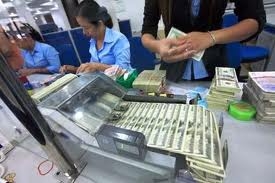Banks struggle to make capital work
 The State Bank yesterday, March 21, 2013 revealed that by the end of February 2013, mobilised capital increased by 2 per cent compared to the end of 2012, double the growth of 2012’s first two months, with VND mobilisation growth higher than foreign currencies.
The State Bank yesterday, March 21, 2013 revealed that by the end of February 2013, mobilised capital increased by 2 per cent compared to the end of 2012, double the growth of 2012’s first two months, with VND mobilisation growth higher than foreign currencies.
However, credit growth continued to be negative in 2013’s first two months at -0.28 per cent. But, the month-on-month credit growth in February 2013 increased by 0.26 per cent instead decreased 1.23 per cent in January.
“The positive thing is VND credit increased by 0.71 per cent in February. The negative credit growth in the first two months of this year was due to the decrease in foreign currency credit, in step with the government’s anti-dollarisation program,” stated the report.
The redundant capital at commercial banks was the reason for the recent reeducation in deposit rates at banks including ACB, Saigon Commercial Bank and BIDV.
At Vietcombank, the deposit rate even reduced by up to 1 per cent, the first time this bank reduced its deposit rate since the State Bank’s policy rate adjustment at the end of last year.
Banking expert Nguyen Tri Hieu said this was a positive trend for under fire enterprises.
“The ideal lending rate at this time is 10 per cent per year, thus the deposit rate should be 7 per cent to suit with the 3 per cent gap between two rates. Inflation in March could be 3 per cent, so the deposit rate might reduce further,” said Hieu.
In 2012, the State Bank already required commercial banks to reduce the lending rate of outstanding loans to 15 per cent, per year. However, many enterprises still claimed loans were still out of reach.
Le Xuan Nghia, a National Advisory Council for Financial and Monetary Policies member, said lenders could reduce rates to 11-13 per cent. “Banks also find it difficult to lend at 15 per cent.”
State Bank Governor Nguyen Van Binh in the conference to deploy monetary measures to support economic growth at Da Nang last week said all eyes were on inflation in March and April. If inflation was 8 per cent, the State Bank would continue to reduce deposit rates.
“However, the possibility to reduce deposit rates is only 1 per cent and each adjustment might be 0.25 per cent, per year. But, there are many reasons to reduce lending rates,” said Binh.
Binh added that State Bank would provide relatively abundant liquidity to create conditions for credit institutions to reduce lending rate. The interbank rate was now stable. Nevertheless, credit institutions would reduce financing costs to help customers.
Based on State Bank’s figures, the current short-term lending rate for agriculture, export and supporting industries, plus small and medium enterprises is around 9-12 per cent per annum.
What the stars mean:
★ Poor ★ ★ Promising ★★★ Good ★★★★ Very good ★★★★★ Exceptional
Related Contents
Latest News
More News
- Tax sector wraps up 2025 and sets priorities for next year (December 25, 2025 | 14:00)
- A tipping point for digital and hybrid wealth management in Vietnam (December 23, 2025 | 13:33)
- $250 million deal targets women-owned SMEs, sustainable agriculture (December 22, 2025 | 17:40)
- Stock market posts resilient 2025 performance (December 19, 2025 | 18:17)
- Citi Vietnam receives 2025 AmCham CSR recognition (December 19, 2025 | 16:35)
- As global green supply chain reshapes, will Vietnam be left behind? (December 19, 2025 | 08:00)
- Banks gear up for massive capital increases (December 18, 2025 | 17:04)
- Securing capital and efficiency for Vietnam’s 2026-2030 growth ambitions (December 17, 2025 | 10:00)
- Energy sector in need of blended finance mechanisms (December 17, 2025 | 09:00)
- Vietnam still has room to mobilise capital for sustainable growth (December 17, 2025 | 08:57)

 Tag:
Tag:





















 Mobile Version
Mobile Version